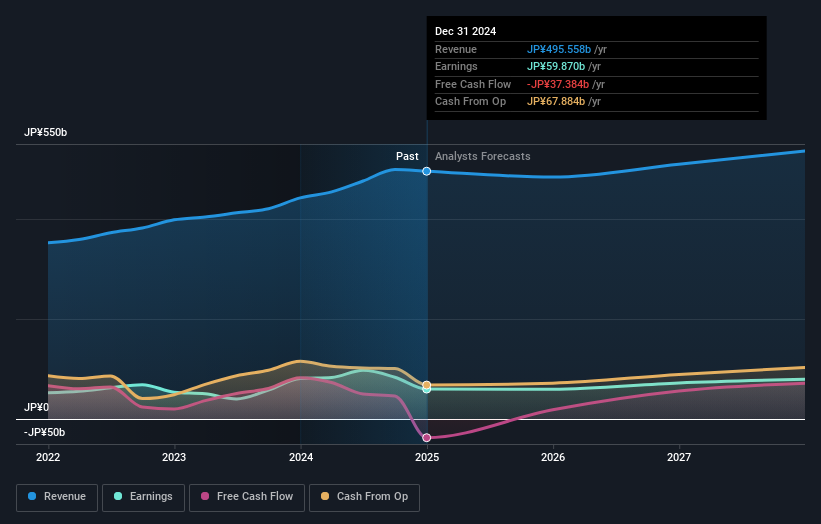Painful week for public companies invested in Kyowa Kirin Co., Ltd. (TSE:4151) after 3.8% drop, institutions also suffered losses

Key Insights
- Kyowa Kirin's significant public companies ownership suggests that the key decisions are influenced by shareholders from the larger public
- Kirin Holdings Company, Limited owns 55% of the company
- 31% of Kyowa Kirin is held by Institutions
If you want to know who really controls Kyowa Kirin Co., Ltd. (TSE:4151), then you'll have to look at the makeup of its share registry. The group holding the most number of shares in the company, around 55% to be precise, is public companies. Put another way, the group faces the maximum upside potential (or downside risk).
While institutions, who own 31% shares weren’t spared from last week’s JP¥44b market cap drop, public companies as a group suffered the maximum losses
Let's take a closer look to see what the different types of shareholders can tell us about Kyowa Kirin.
Check out our latest analysis for Kyowa Kirin

What Does The Institutional Ownership Tell Us About Kyowa Kirin?
Institutional investors commonly compare their own returns to the returns of a commonly followed index. So they generally do consider buying larger companies that are included in the relevant benchmark index.
Kyowa Kirin already has institutions on the share registry. Indeed, they own a respectable stake in the company. This suggests some credibility amongst professional investors. But we can't rely on that fact alone since institutions make bad investments sometimes, just like everyone does. When multiple institutions own a stock, there's always a risk that they are in a 'crowded trade'. When such a trade goes wrong, multiple parties may compete to sell stock fast. This risk is higher in a company without a history of growth. You can see Kyowa Kirin's historic earnings and revenue below, but keep in mind there's always more to the story.

We note that hedge funds don't have a meaningful investment in Kyowa Kirin. Kirin Holdings Company, Limited is currently the company's largest shareholder with 55% of shares outstanding. With such a huge stake in the ownership, we infer that they have significant control of the future of the company. In comparison, the second and third largest shareholders hold about 9.4% and 3.3% of the stock.
While studying institutional ownership for a company can add value to your research, it is also a good practice to research analyst recommendations to get a deeper understand of a stock's expected performance. There are a reasonable number of analysts covering the stock, so it might be useful to find out their aggregate view on the future.
Insider Ownership Of Kyowa Kirin
While the precise definition of an insider can be subjective, almost everyone considers board members to be insiders. Management ultimately answers to the board. However, it is not uncommon for managers to be executive board members, especially if they are a founder or the CEO.
Insider ownership is positive when it signals leadership are thinking like the true owners of the company. However, high insider ownership can also give immense power to a small group within the company. This can be negative in some circumstances.
Our information suggests that Kyowa Kirin Co., Ltd. insiders own under 1% of the company. It is a pretty big company, so it would be possible for board members to own a meaningful interest in the company, without owning much of a proportional interest. In this case, they own around JP¥535m worth of shares (at current prices). It is always good to see at least some insider ownership, but it might be worth checking if those insiders have been selling.
General Public Ownership
With a 14% ownership, the general public, mostly comprising of individual investors, have some degree of sway over Kyowa Kirin. This size of ownership, while considerable, may not be enough to change company policy if the decision is not in sync with other large shareholders.
Public Company Ownership
Public companies currently own 55% of Kyowa Kirin stock. We can't be certain but it is quite possible this is a strategic stake. The businesses may be similar, or work together.
Next Steps:
It's always worth thinking about the different groups who own shares in a company. But to understand Kyowa Kirin better, we need to consider many other factors. Consider risks, for instance. Every company has them, and we've spotted 2 warning signs for Kyowa Kirin you should know about.
Ultimately the future is most important. You can access this free report on analyst forecasts for the company .
NB: Figures in this article are calculated using data from the last twelve months, which refer to the 12-month period ending on the last date of the month the financial statement is dated. This may not be consistent with full year annual report figures.
Valuation is complex, but we're here to simplify it.
Discover if Kyowa Kirin might be undervalued or overvalued with our detailed analysis, featuring fair value estimates, potential risks, dividends, insider trades, and its financial condition.
Access Free AnalysisHave feedback on this article? Concerned about the content? Get in touch with us directly. Alternatively, email editorial-team (at) simplywallst.com.
This article by Simply Wall St is general in nature. We provide commentary based on historical data and analyst forecasts only using an unbiased methodology and our articles are not intended to be financial advice. It does not constitute a recommendation to buy or sell any stock, and does not take account of your objectives, or your financial situation. We aim to bring you long-term focused analysis driven by fundamental data. Note that our analysis may not factor in the latest price-sensitive company announcements or qualitative material. Simply Wall St has no position in any stocks mentioned.
About TSE:4151
Kyowa Kirin
Engages in the research, development, manufacturing, marketing, and import/export of pharmaceuticals for oncology, nephrology, central nervous system, and immunology therapeutic areas in Japan, the United States, rest of the Americas, Europe, Asia, and internationally.
Flawless balance sheet, good value and pays a dividend.
Similar Companies
Market Insights
Community Narratives





